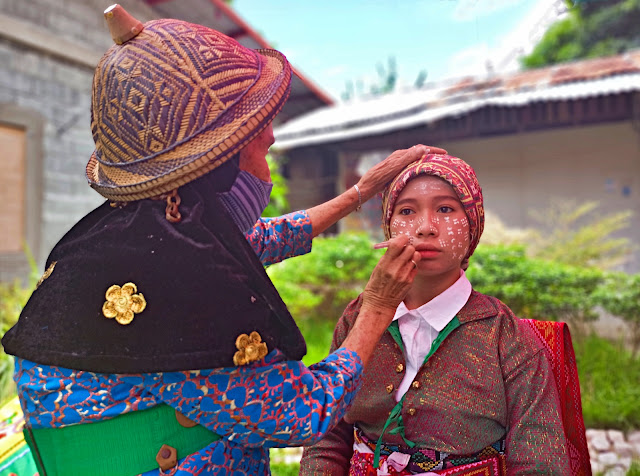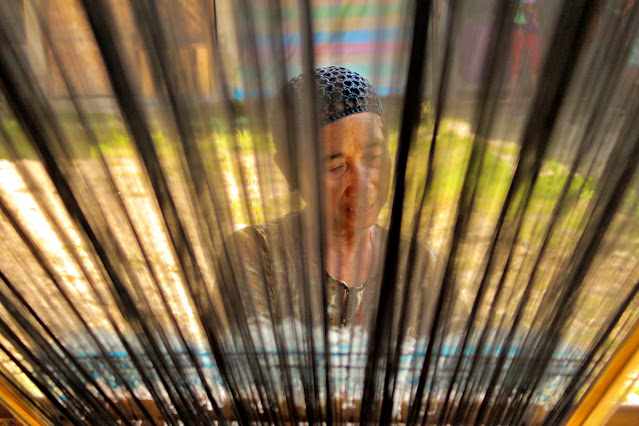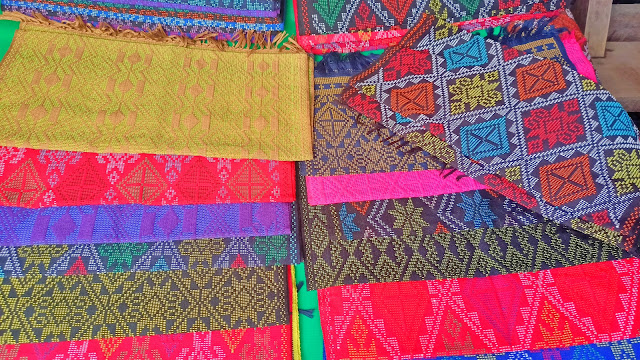A few days removed from being graced by the presence of National Living Treasure awardee Apuh Ambalang — a Yakan master weaver who unfortunately passed away at age 78 in February 2022 — in Lamitan, Basilan, we continued our discovery of the 'Habi' (weaving) culture of Zamboanga Peninsula by making an educational stop at the Yakan Village in Zamboanga. Despite the fact that this was my second visit to this Yakan cultural hub, I was immediately captivated by the vibrant woven creations displayed in the rows of stalls that greeted us after we alighted from our vans.
Watching
the Weavers Weave
Around the village. colorful 'tennun' hangs in eye-catching fashion popping with rich colors and hypnotic patterns. "Tennun" in Yakan means any woven cloth used in weaving a Yakan dress. The Yakans eventually expanded their indigenous art creations by weaving other items such as trouser, table runner, apron, brass buttons, sash, scarf, malong, pillowcases, and even bags and shoes. They also introduced new designs such as the vine-patterned dawen-dawen, the diamond-shaped kabang buddi, and a few others inspired by everyday objects.
Yakan hand-loomed fabrics are well-known for their use of geometric patterns in complementary and contrasting colors. Each cloth's design, like that of other traditional woven creations from Mindanao, refers to a specific cultural and historical narrative.
When you’re finished buying some of their creations, you can watch some of the weavers at work, as several of them have a weaving machine set up inside their stores. This will give you a newfound appreciation for the amount of time, effort, and artistry that goes into each tennun creation, with most taking an average of 5 hours for a small piece and up to two weeks for a long tennun cloth.
Aside from woven fabrics, the village also sells a large collection of antiques and trinkets related to Mindanaoan culture, particularly that of the Zamboanga Peninsula region.
The
Facial Art of Tanyak-Tanyak
We met Apuh Jahlinan Ilul, a cousin of Apuh Ambalang Ausalin, after climbing the stairs to the upper level of the village. Despite the fact that we spoke different languages, we were able to communicate with each other thanks to her granddaughter, who served as our translator.
Apuh Jahlinan, it turns out, wanted to demonstrate the Yakan facial art of "Tanyak-Tanyak." A tradition unique to the Yakans, the Tanyak-Tanyak is worn by a bride on her wedding day.
This Yakan face painting tradition involves the use of bamboo implements and powder made from rice grains and then mixed with water. It is then painted in the shape of miniature patterns such as circles, crescents, and diamonds on the face of a young lady. They recently substituted talcum powder for rice grains to make the process easier.
Apuh Ilul's granddaughter enthusiastically agreed to be the model. Once the process of applying the tanyak-tanyak started, the young lady's tiny-shaped face blended beautifully with the intricate designs Apuh was drawing in tiny and steady strokes.
A
Return to Normal
As we approach the tail-end of the pandemic, the Yakan Village in Zamboanga brightens up the cultural scene once more, thanks to the collective colorful culture that is preserved here.
What we visitors can do to help their weavers' community return to normalcy is to show our appreciation for their art and culture. What better way to assist the Yakans preserve their woven tradition than to obtain a piece or two — or more — so we can bring a piece of Yakan culture into our homes — not only for posterity and display purposes, but also to help the Yakans preserve their beautiful weaving tradition.































